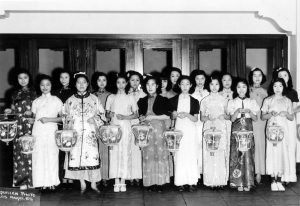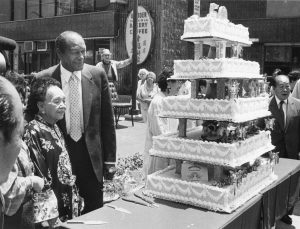May is Asian American and Pacific Islander Heritage Month, when we pay tribute to and recognize the generations of Asians, Native Hawaiians, and Pacific Islanders who have enriched American history and are instrumental to its present and future success.
The celebration began as Asian Pacific Heritage Week in 1978, thanks to efforts by U.S. Representatives Frank Horton (R-N.Y.) and Norman Mineta (D-Calif.) and U.S. Senators Daniel Inouye and Spark Matsunaga from Hawaii, and was extended to a month in 1990 by President George H. W. Bush. The month of May was chosen because it commemorates the migration of the first immigrants from Japan to the U.S. on May 7, 1843, and to celebrate the completion of the transcontinental railroad by more than 20,0000 Asian immigrants on May 10, 1869.

Young women in traditional Chinese dress with lanterns at Moon Festival celebration (1940). Photo: Los Angeles Public Library, Harry Quillen Photo Collection.
Asian Americans include U.S. citizens whose origins are from China, Japan, Taiwan, Korea, Mongolia, Vietnam, Laos, Cambodia, Thailand, India, Sri Lanka, Pakistan, Bangladesh, Nepal, Myanmar, Bhutan, the Philippines, Indonesia, and Malaysia, as well as Native Hawaiians and Pacific Islanders from Samoa, Fiji, Guam, and the Northern Mariana Islands. According to the Pew Research Center, Asian Americans were the fastest-growing population in the U.S. between 2000 and 2019.
Libraries and library organizations of all types across the country are celebrating Asian American and Pacific Islander Heritage Month with programs ranging from STEAM events, videos, and concerts to curated resources available online and on location, author talks, and film screenings.
We’re particularly moved by Stories and Voices from L.A. Chinatown, the first in the Archive Alive series, a collaboration between the Huntington Library, Art Museum, and Botanical Gardens; the Library Foundation of Los Angeles; and the Los Angeles Public Library (LAPL). Archive Alive activates historic photographs, documents, and maps drawn from the Huntington’s and LAPL’s collections through online exhibitions, site-specific installations and displays, and interviews with community members, whose personal reflections and connections bring the archives to life. Stories looks at the history and influence of Los Angeles’s Chinatown through photos, videos, testimonies, and more to create a living portrait of the vibrant neighborhood.

Mayor Tom Bradley and community leader and restaurateur Mama Quon celebrate the 50th Anniversary of New Chinatown (1988). Photo: Los Angeles Public Library, Herald Examiner Photo Collection.
Organized thematically, Stories examines the opportunities created by the establishment of L.A.’s Chinatown; the vision behind the neighborhood; how Chinatown became a refuge for Chinese Americans after the Chinese Exclusion Act of 1882, which wasn’t repealed until 1943; the resilience of Chinese Americans; and the importance of community and traditions in Chinatown.
In addition to the impeccable materials and commentary, LAPL also includes links to vital resources, including links to Stop AAPI Hate, which tracks and responds to acts of hate, violence, and discrimination against Asian Americans and Pacific Islanders; the library’s API Solidarity Statement, with social justice-oriented reading suggestions for all ages; the Chinese Historical Society of Southern California, a Chinatown-based center for research, exhibits, and community programming; the Chinese American Museum, housed in the last remaining structure from Old Chinatown, which features exhibitions and educational programs on the experiences of Chinese Americans in Southern California and beyond; and much more.
Experience Stories and Voices from L.A. Chinatown. It’s a thoroughly fascinating, impeccably curated, and important collection that should be a must-see experience for all Americans. And visit the Asian/Pacific American Librarians Association to learn more about leadership opportunities and resources available for Asian Americans, Native Hawaiians, and Pacific Islanders in the library community.
Feature image: Young women in traditional Chinese dress with lanterns at Moon Festival celebration (1940); Los Angeles Public Library, Harry Quillen Photo Collection.




